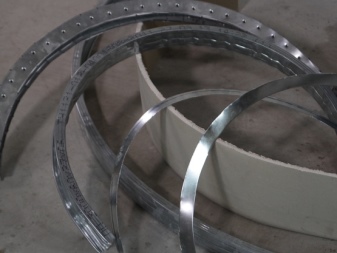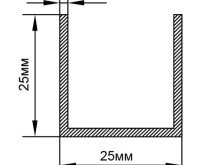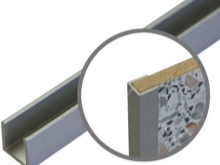All about aluminum U-shaped profiles

The aluminum U-shaped profile is both a guide and a decorative element for furniture and interior structures. It extends their service life by giving specific products a finished look.

Peculiarities
A U-shaped profile, unlike a sheet or a pin, is much more difficult to bend. In industrial conditions, it is either welded by cutting at an angle of 45 degrees, or bent while heating over a burning gas. Aluminum and brass profiles are difficult to weld, which cannot be said about steel. Cold bending of the profile (without heating) is possible only along.
It can be bent back into the strip of metal from which it was cast. Unlike the L-shaped profile, in which the main face is replaced only by the edge of a right angle, and U-shaped, where the main face has the shape of a semi-oval or semicircle, the U-shaped one has equal and perfectly smooth edges. But the width of each of the side faces is not always equal to the width of the main one.


If you place an additional middle one between the side faces, which is an intermediate stiffener, then the U-shaped profile will become W-shaped. A you can turn it into an L-shaped one by cutting one of the side edges or bending it inward.


In the latter case, it will succeed if the width of the main face allows. Thin profiles (with a wall thickness of up to 1 mm) bend easily, straighten back into a sheet (strip), bend in both directions. With those that are thicker, doing this is much more difficult.
Thin steel profiles are made by longitudinal bending of sheet metal. Unlike steel, which can be bent and straightened up to several times without much negative impact on strength, aluminum and its alloys break easily. It is better to purchase an aluminum profile with the required dimensions in advance than to alter one that did not fit into the required seat on the structure.



Coating options
There are two types of coating: additional metallization and application of polymer (organic) films. Anodized profile - a product immersed in a solution of a certain metal salt. A vessel into which, for example, a steel profile (and any other product made of the same metal) is immersed, is filled with a salt solution.
Aluminum chloride is popular. On the electrode, which the profile itself serves, in accordance with the laws of electrolytic dissociation, metallic aluminum is released. The opposite has bubbles of gaseous secretions that have just been part of the aluminum salt. The same chlorine can be easily identified by its smell.


Similarly, for example, copper plating of an aluminum profile is carried out (for cases when structural fragments are connected by soldering). Soldering is an alternative method of joining copper-plated aluminum, which is not inferior to welding: high-temperature solders based on lead, tin, zinc, antimony and other metals and semimetals, suitable for strong bonding of metal components, are used for soldering aluminum-shaped structures.
Anodizing copper and bronze profiles is impractical due to their low prevalence due to the high cost of copper and tin.

Painting a U-shaped profile (and fragments of other types other than the profile as such), for example, in black, is advisable to carry out as follows.
- Application of a special primer-enamel that reacts with a surface oxide film (aluminum oxide).But since the oxide coating protects aluminum from moisture in dry weather no worse than the paint itself, this option is rarely used. The profile is covered with such a composition only when it is often watered or immersed in water. Water with impurities, for example, traces of acids, alkalis and salts, destroys aluminum: it is even more active than zinc.
- Pre-sanding with an emery wheel or wire brush. This attachment is screwed onto the grinder instead of the standard saw blade. The rough surface of the U-profile, which has lost its glossy shine, can be easily painted with any paint, even standard oil paint, which was used to cover wooden windows and doors.
- Bonding of decorative films. The colors are chosen by the customer. The work is done very carefully, in calm weather and in a place free from dust.
Having decided on the type of coating and the appearance of the profile, the customer finds the fragment size suitable for him.


Dimensions (edit)
A profile is not the type and type of building and finishing material that is wound into coils and wound on spools like wire or reinforcement. For ease of transportation, it is cut into segments 1, 2, 3, 4, 5, 6, 10 and 12 m long: it all depends on the dimensions. On the domestic and import market of building materials, products of the following size range are presented:
- 10x10x10x1x1000 (the width of the main and two sides, metal thickness and length are indicated, all in millimeters);
- 25x25x25 (length ranges from one to several meters, cut to order, like other standard sizes);
- 50x30x50 (wall thickness - 5 mm);
- 60x50x60 (wall 6 mm)
- 70x70x70 (wall 5.5-7 mm);
- 80x80x80 (thickness 6, 7 and 8 mm);
- 100x80x100 (wall thickness 7, 8 and 10 mm).
The latter option is rare. Although aluminum is one of the cheapest and most common metals, it is combined with zinc (brass profile) to save money. Recently, magnesium alloys with aluminum are also widespread. A profile with such a thick wall weighs a lot: several linear meters can reach a weight of 20 or more kilograms.



The designations of the dimensions and molding of the profile may vary.
- Small U-shaped profiles, most often used for furniture and bath screens, have a rectangular (not square) section and a distance between the side walls of 8, 10, 12, 16, 20 mm. The dimension of such elements is presented in the form of the width of the apical (main) and one of the side walls, for example, 60x40, 50x30, 9x5 mm. For a square U-shaped profile, which looks like a professional pipe with one cut off wall, the designations inherent in professional pipes are used: 10x10, 20x20, 30x30, 40x40, 50x50 mm. Sometimes the width of one wall is simply indicated - 40 mm.
- There is also a four-dimensional indication of dimensions, for example, 15x12x15x2 (here 12 mm is the width of the top of the section, 2 is the thickness of the metal).
- There is also a three-dimensional description of the dimensions, for example, in the case of narrow side and wide main edges. Often there are parameters in 5x10x5, 15x10x15 mm.
- If the profile is the same in height and width, then sometimes the designation is used, for example, 25x2 mm.


In all cases, GOST prescribes reporting full-size dimensions in millimeters. The goods should be indicated as clearly as possible in the format of a certain sequence:
- the width of the main part;
- left side stripe width;
- right side width;
- the thickness of the metal (walls), while all the walls will be the same;
- length (molding).
Making non-standard sizes (with a thicker top or sidewalls, different widths of side edges, etc.), the manufacturer indicates simplified sizes for such customers.
But such cases are very rare: almost always rolling and foundries adhere to a strict standard-size catalog that does not have any deviations.



Applications
The U-shaped profile is used in different areas.
- As furniture guides, when the castors are lowered into the profile, each of which is held on a leg.The profile, turned upside down, acts as a kind of rails that prevent the wheel structures from deviating to the side. For glass, a U-shaped profile-holder can be used, which acts as a frame. The movement of glass in both directions is not provided: sliding furniture glass is an element of the W-, not the U-shaped profile.
- As an element of a single-glazed window unit or an interior door. Double glazing provides for an W-shaped section of the profile.
- For the decoration of chipboard sheets, decorated with matte paint, decorative waterproof varnish or film with a "wooden" texture. The U-profile is mounted on the board using countersunk head bolts, the nuts with press and grover washers are hidden below (on the side opposite and invisible to the visitor).
- Plasterboard sheets (GKL) use the same design. The sheet itself is installed as a partition, covered with putty (plastering) and water-dispersion paint or whitewash. But the sheets can be attached to the U-profile, which is previously screwed from all sides to the load-bearing walls, ceiling and floor, and without seizing the end side. If the profile does not exceed a thickness of 1 mm, wooden spacers are installed to protect against bends at the place where the gypsum board is screwed into the metal structure. However, not aluminum is used for drywall, but galvanized (anodized) steel.
The aluminum profile can be used as a structural element of tents and tents, as well as when arranging a home on wheels - a trailer, where the wheel base of the trailer itself plays the role of a foundation. This makes it possible to somewhat lighten the total weight of the trailer, and with it reduce the cost of gasoline and engine wear.
















The comment was sent successfully.